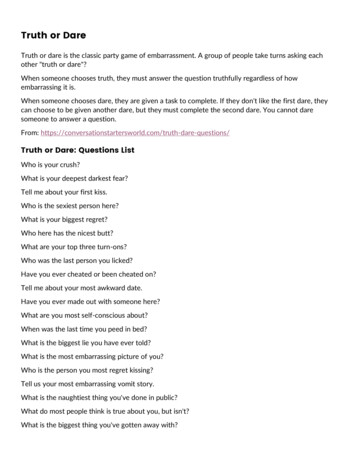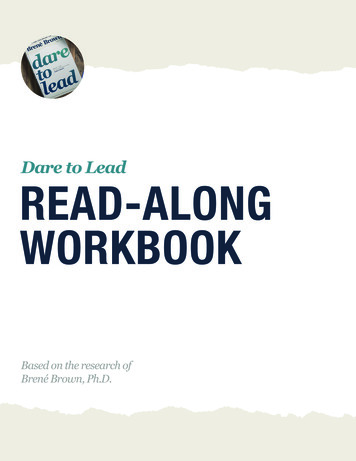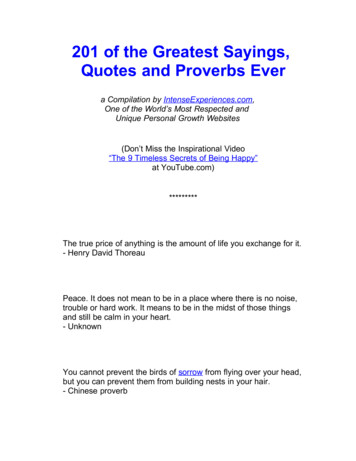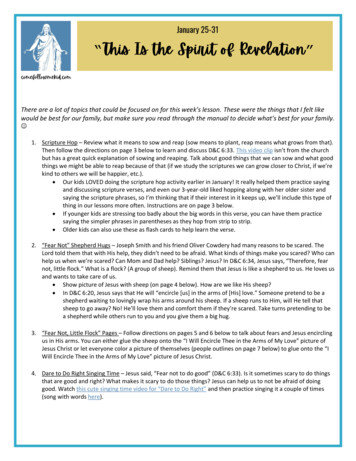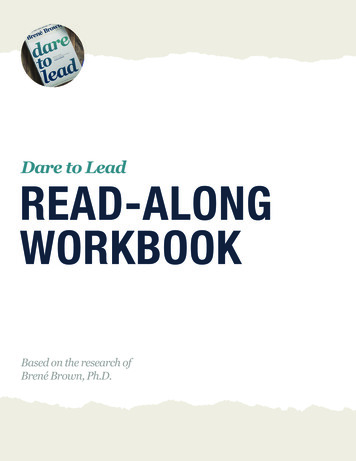
Transcription
Dare to LeadREAD-ALONGWORKBOOKBased on the research ofBrené Brown, Ph.D.
“Knowledge is only rumoruntil it lives in the bones.”The Asaro TribeWe want to do everything we can to help you get courageous leadership skills in yourbones. We made Dare to Lead as tactical and actionable as possible, and this read-alongworkbook will help you put language, skills, and tools into practice.This workbook is a companion to the book - the book has the teachings and theworkbook has the exercises.Also, this workbook was developed for use by teams (3 or more) and individuals workingin pairs. You can certainly do this work on your own, but it’s more powerful with anotherperson. If you don’t have a colleague at work who can do this with you, find a friend orpartner in other areas of your life. They can talk about their work experiences and youcan talk about yours. Either way you’re sharing and learning from each other.Let’s get started.01. We suggest you get a printed copy of Dare to Lead. We love audiobooks andreading on our e-readers, but these formats are much more complicated to usewith a companion workbook. We’ll be referencing page numbers when asking youto find and re-read pieces.02. If you’re working with a team or group, decide how often you want to meet andwho’s going to coordinate those sessions. Check out our “Read-Along Schedule”on the Dare to Lead hub on brenebrown.com for support in creating a schedule.03. For each exercise, we’ve included Exercise Instructions for sharing as a team.It’s a good idea to read through these instructions so you understand the processbefore you complete your work.04. There’s not a right way to start. You can read the entire book and then workthrough the exercises, referring back to sections you’ve already read. Or you canread one section at a time and complete the workbook as you go.05. You can find our Glossary of Key Language, Skills, Tools and Practices on thedownloads section of the Dare to Lead hub on brenebrown.com.06. Materials: Everyone participating will need pens, sticky notes, and their own workbook. Teams will need poster-sized post-it notes or flip chart paper and tape.Copyright 2018 by Brené Brown, LLC All rights reserved v1.0 October 9, 2018 www.brenebrown.com/daretolead1/39
What’s OK and What’s Not OKIt’s ok to use Dare to Lead and this read-along workbook with your teams, groups,clubs, or entire organizations. Share, discuss, and learn!It’s NOT ok to use the workbook for commercial use. You can’t sell it, sell workshopsthat you’ll facilitate based on it, or create a website redistributing the workbook.If you’re interested in digging deeper with your organization, hiring aCertified Dare to Lead Facilitator, becoming a Certified Dare to LeadFacilitator, or training your internal trainers, visit the Dare to Lead hub onbrenebrown.com to learn more about the other programs we offer.Copyright 2018 by Brené Brown, LLC All rights reserved v1.0 October 9, 2018 www.brenebrown.com/daretolead2/39
N OT TH E M A N WH O P O I N TS O U T HOW THE STRO N GMA N STU M BL E S , O R W HERE THE DO ER O F DEEDSCO U L D H AV E DO N E THEM BETTER.THECR E DITBE LONG STOTHEMANW HOISAC TUA L LY IN TH E ARENA , W HOSE FAC E I S M A RREDBY DU ST A N D SWEAT AN D BLO OD; W HO STRI VESVALIA N TLY. . . WH O AT THE BEST KNOWS I N THEE N D TH E TR IU M P H OF HI G H AC HI EVEM EN T, A N DW HO AT TH E WO R ST, I F HE FAI LS, AT LEAST FA I LSW HIL E DA R IN G G R EATLY.Copyright 2018 by Brené Brown, LLC All rights reserved v1.0 October 9, 2018 www.brenebrown.com/daretolead3/39
IntroductionBRAVE LEADERS AND COURAGE CULTURESExercise 1: Permission SlipsContent and exercise covered on page 53 of Dare to Lead.Permission slips are a great way to start building trust in a group and to start containerbuilding. If you’re working on your own, it’s a helpful tool to identify what might get inyour way of learning and practicing new ways of showing up.What do you need to give yourself permission to do, feel, or not do toshow up for this read-along?Sometimes the first step in getting startedis giving ourselves permission. Maybe youneed to give yourself permission to:Or if you’re doing this in a groupsetting, permission to:01. Stay open minded02. Ask for what you need02. Give yourself the time you need03. To pass during group sharing03. Make a list of questions04. Ask for more time01. Show up to the group meetingsWrite your permission slips below or on a sticky note.Feel free to have more than one.Exercise Instructions: We like to round robin this exercise – basically go aroundthe table at a quick but reasonable pace and let everyone share their permissionslip(s). Everyone listens and holds comments until everyone has shared. The power inthe round robin is finding commonalities. Sometimes that’s harder to recognize whenpeople share entire worksheets instead of one set of answers going around the table, orwhen there’s cross talk in the middle of sharing. This is also a good check-in exercise ifyou want to start meetings with, “What new permission slips do we need today?”Copyright 2018 by Brené Brown, LLC All rights reserved v1.0 October 9, 2018 www.brenebrown.com/daretolead4/39
Exercise 2: Container BuildingContent and exercise covered on page 36 of Dare to Lead.Whether you’re working in a large team or with a good friend, DO NOT SKIPthis exercise.Have each person in the group answer the following questions individuallyon sticky notes: What do you need to show up and do the work? What will get in the way of you showing up and doing the work? What does support look like?Have everyone share their answers and use them to develop group ground rulesthat you can use in all of your discussions.Copyright 2018 by Brené Brown, LLC All rights reserved v1.0 October 9, 2018 www.brenebrown.com/daretolead5/39
Exercise 3: What Stands in the Way Becomes the WayContent covered on pages 7-8 of Dare to Lead.In Dare to Lead, we learn about ten behaviors and cultural issues that leadersidentified as getting in our way in organizations across the world.01. We avoid tough conversations, including giving honest, productive feedback.02. Rather than spending a reasonable amount of time proactivelyacknowledging and addressing the fears and feelings that show up duringchange and upheaval, we spend an unreasonable amount of time managingproblematic behaviors.03. Diminishing trust caused by a lack of connection and empathy.04. Not enough people are taking smart risks or creating and sharing bold ideasto meet changing demands and the insatiable need for innovation.05. We get stuck and defined by setbacks, disappointments, and failures,so instead of spending resources on clean-up to ensure that consumers,stakeholders, or internal processes are made whole, we are spending toomuch time and energy reassuring team members who are questioning theircontribution and value.06. Too much shame and blame, not enough accountability and learning.07. People are opting out of vital conversations about diversity and inclusivitybecause they fear looking wrong, saying something wrong, or being wrong.Choosing our own comfort over hard conversations is the epitome ofprivilege, and it corrodes trust and moves us away from meaningful andlasting change.08. When something goes wrong, individuals and teams are rushing intoineffective or unsustainable solutions rather than staying with problemidentification and solving. When we fix the wrong thing for the wrongreason, the same problems continue to surface. It’s costly and demoralizing.09. Organizational values are gauzy and assessed in terms of aspirations ratherthan actual behaviors that can be taught, measured, and evaluated.10. Perfectionism and fear are keeping people from learning and growing.Copyright 2018 by Brené Brown, LLC All rights reserved v1.0 October 9, 2018 www.brenebrown.com/daretolead6/39
Exercise 3: What Stands in the Way Becomes the Way (continued)Content covered on pages 7-8 of Dare to Lead.Exercise Instructions: Think about this list of behaviors, then decide if you wantto talk about these obstacles in the context of your team, your organization, or anyother relevant unit. Once you decide, have everyone write down the three that you thinkpresent the most significant barriers to courageous leadership in that unit. Make sureeveryone has a shared understanding of the unit you’re assessing.Once everyone is done, you’ll use the Turn & Learn to share your top three (everyoneshows their post-it at the same time to avoid halo and bandwagon issues – see page 55).Discuss similarities and differences. Do people in different roles have differentexperiences? Are there two that your team is willing to hold in mind while you’reworking through this read-along process?Copyright 2018 by Brené Brown, LLC All rights reserved v1.0 October 9, 2018 www.brenebrown.com/daretolead7/39
Part OneRUMBLING WITH VULNERABILITYSection One: The Moment and the MythsExercise 1: Square SquadContent and exercise covered on page 22 of Dare to Lead.“We need to trust to be vulnerable, and we need to be vulnerable in order to build trust.”Write the names of the people whose opinions really matter to you within the square.Exercise Instructions: How you process this exercise with a group depends onthe level of trust in the group. One of the most effective ways to share without askingindividuals to disclose who’s in their square squad is to ask these two questions:01. What did you learn from the process of thinking about who belongs in the square?02. Do you, like most of us, find yourself steam-rolling over these important peoplein your life to gain the acceptance and approval of strangers? If so, what’sone commitment you can make to strengthen the squad and spend less timeapproval-seeking?Have each person in your group share their answers to both #1 and #2, thenmove to the next person.Copyright 2018 by Brené Brown, LLC All rights reserved v1.0 October 9, 2018 www.brenebrown.com/daretolead8/39
Exercise 2: The Six Myths of VulnerabilityContent covered on pages 23-42 of Dare to Lead.Thinking about the six myths of vulnerability, complete or answer the following:01. I grew up believing that vulnerability was 02. For me, vulnerability feels like What does it physically feel like for me? What does it emotionally feel like forme? What am I thinking?03. For each of the six myths of vulnerability, rate on a scale of 1-5 how much youneed to “unlearn.” (1 none, 5 a lot)Vulnerability is weakness.I don’t do vulnerability.I can go it alone.You can engineer the uncertainty and discomfort out of vulnerability.Trust comes before vulnerability.Vulnerability is disclosure.04. In my organization, the messages and expectations about vulnerability are 05. When was the last time you saw someone bravely facing uncertainty, risk, andemotional exposure?06. When was the last time you bravely faced uncertainty, risk, and emotional exposure?Copyright 2018 by Brené Brown, LLC All rights reserved v1.0 October 9, 2018 www.brenebrown.com/daretolead9/39
Exercise 2: The Six Myths of Vulnerability (continued)Content covered on pages 23-42 of Dare to Lead.07. When you reflect on how you want to show up and be seen as a leader, what dovulnerability and courage look like for you?08. What is one way you’ll experiment with being more vulnerable at work?Exercise Instructions: This is an important exercise to round robin – meaningeveryone completes the exercises then shares their answers to #1. Next, everyoneshares their answers to #2, and so on. Don’t forget to give yourself and otherspermission to pass!Copyright 2018 by Brené Brown, LLC All rights reserved v1.0 October 9, 2018 www.brenebrown.com/daretolead10/39
Part OneRUMBLING WITH VULNERABILITYSection Two: The Call to CourageExercise 1: Assembling Your ArmorContent covered on pages 51-52 of Dare to Lead.We all use armor to protect ourselves, but that armor is heavy and prevents us fromgrowing, being seen, and being in connection with others. When we’re in fear, or anemotion is driving self-protection, there’s a fairly predictable pattern of how we assembleour armor, piece by piece: I’m not enough. If I’m honest with them about what’s happening, they’ll think less of me ormaybe even use it against me. No way am I going to be honest about this. No one else does it. Why do I haveto put myself out there? Yeah. Screw them. I don’t see them being honest about what scares them. Andthey’ve got plenty of issues. It’s actually their issues and shortcomings that make me act this way. This istheir fault, and they’re trying to blame me. In fact, now that I think about it, I’m actually better than them.01. What are two situations that are likely to lead to you armoring up?02. What does your “armoring up” process look like?a. My body language?b. My words?c. My thoughts?d. My go-to transformer behaviors?Exercise Instructions: We do NOT round robin this exercise. We find it helpful tohave participants share all of their answers, and then move on to the next person. Wesuggest no cross talk and reminding people that they can pass. Also, remind people tostay mindful about time so everyone can share.Copyright 2018 by Brené Brown, LLC All rights reserved v1.0 October 9, 2018 www.brenebrown.com/daretolead11/39
Exercise 2: The Cave You Fear to EnterContent covered on pages 52-53 of Dare to Lead.01. What is your personal call to courage as a leader? Be specific.Ex. I want to be braver at giving constructive feedback.02. What is the cave you fear to enter and why?Ex. My cave is looking at the engagement problems in my organization.Exercise Instructions: We do NOT round robin this exercise. We find it helpful tohave participants answer both of these questions in one turn. We suggest no cross talkand reminding people that they can pass. Also, remind people to stay mindful abouttime so everyone can share.Copyright 2018 by Brené Brown, LLC All rights reserved v1.0 October 9, 2018 www.brenebrown.com/daretolead12/39
Exercise 3: Gritty Faith and Gritty FactsContent covered on page 57 of Dare to Lead.Brave leaders must rely on gritty faith and gritty facts at the same time.01. On a scale from 1-4, how often does your team or group balance gritty faith andgritty facts in your decision making at work?(1 we never balance 2 we sometimes balance 3 we often balance 4 wealways balance)02. Have you fallen into dangerous patterns where people assume the roles ofoptimists and realists, the dreamers and the reality-checkers, etc.?(Yes / No)2a. If yes, what language would you use to describe the roles?Rumble together on how not balancing gritty faith and gritty facts holds you back.Exercise Instructions: Use the Turn & Learn to share your rating from question#1. Then, round robin the answers to #2 and #2a. Discuss similarities and differences.Do people in different roles have different experiences?Copyright 2018 by Brené Brown, LLC All rights reserved v1.0 October 9, 2018 www.brenebrown.com/daretolead13/39
“Leaders must either invest a reasonable amount of time attending to fears andfeelings, or squander an unreasonable amount of time trying to manage ineffectiveand unproductive behavior.”- Brené BrownExercise 4: Care and ConnectionContent covered on pages 70-75 of Dare to Lead.01. In reference to the quote above, what gets in the way of leaders doing this in yourorganizational culture?02. What is keeping you as a leader from digging into the fears and concerns of yourcolleagues and/or teams?03. What are the cultural barriers that prevent you from doing this?04. What’s one commitment everyone is willing to make to start attending to fearsand feelings, and what does support look like?Exercise Instructions: These questions lend themselves to open discussion.To manage time and focus thoughts, we suggest hanging three posters in the room, onewith each question written at the top. Ask everyone to write 1 or 2 answers on a stickynote and hang them on the corresponding poster. Before the discussion starts, havea quick silent walk where you give people 5-10 minutes (depending on group size) toread the post-its. The silent part is important because it’s easy for two people to startcommenting on a post-it not knowing the author is standing beside them. Once the walkis over, allot 10 minutes per question for discussion.Copyright 2018 by Brené Brown, LLC All rights reserved v1.0 October 9, 2018 www.brenebrown.com/daretolead14/39
Part OneRUMBLING WITH VULNERABILITYSection Three: The ArmoryExercise 1: Armored Leadership versus Daring LeadershipContent covered on pages 76-114 of Dare to Lead.“Courage is contagious. To scale daring leadership and build courage in teams andorganizations, we have to cultivate a culture in which brave work, tough conversations,and whole hearts are the expectation, and armor is not necessary or rewarded.”- Brené BrownNow is a good time to revisit your permission slips and/or container building as we digdeeper into the work.Exercise Instructions:01. For each of the 16 elements on the model on the next page, rate your team’sculture on the spectrum of Armored Leadership (1 point) to Daring Leadership (4points). You can refer back to the book for fuller explanations of the concepts.02. Add up the number of points and enter that total in the top of the model. Yourtotal will be somewhere between 16 and 64.03. Write that total on a sticky note and use the Turn & Learn process to share yourtotal with the group.04. As a team, decide on the two most daring and the two most armored behaviorsyour team displays.05. Dig into the cultural norms influencing these behaviors. For example, what arethe rewards for daring versus armored leadership?06. What is one shared commitment that everyone can make as a group to create amore daring leadership culture?Copyright 2018 by Brené Brown, LLC All rights reserved v1.0 October 9, 2018 www.brenebrown.com/daretolead15/39
Exercise 1: Armored Leadership versus Daring Leadership (continued)Content covered on pages 76-114 of Dare to Lead.Armored LeadershipTotal:Daring Leadership01.Driving Perfectionism andFostering Fear of Failure1 2 3 4Modeling and EncouragingHealthy Striving, Empathy,and Self-Compassion02.Working from Scarcity andSquandering Opportunities forJoy and Recognition1 2 3 4Practicing Gratitude andCelebrating Milestonesand Victories03.Numbing1 2 3 4Setting Boundaries andFinding Real Comfort04.Propagating the FalseDichotomy of Victim or Viking,Crush or Be Crushed1 2 3 4Practicing Integration—Strong Back, Soft Front,Wild Heart05.Being a Knower and Being Right1 2 3 4Being a Learner andGetting It Right06.Hiding Behind Cynicism1 2 3 4Modeling Clarity,Kindness, and Hope07.Using Criticism as SelfProtection1 2 3 4Making Contributions andTaking Risks08.Using Power Over1 2 3 4Using Power With, PowerTo, and Power Within09.Hustling for Our Worth1 2 3 4Knowing Our Value10.Leading for Complianceand Control1 2 3 4Cultivating Commitmentand Shared Purpose11.Weaponizing Fear andUncertainty1 2 3 4Acknowledging, Naming,and Normalizing CollectiveFear and Uncertainty(chart continued on next page)Copyright 2018 by Brené Brown, LLC All rights reserved www.brenebrown.com/daretolead16/30
Exercise 1: Armored Leadership versus Daring Leadership (continued)Content covered on pages 76-114 of Dare to Lead.Armored LeadershipDaring Leadership12.Rewarding Exhaustion as aStatus Symbol and AttachingProductivity to Self-Worth1 2 3 4Modeling and SupportingRest, Play, and Recovery13.Tolerating Discrimination,Echo Chambers, and a “FittingIn” Culture1 2 3 4Cultivating a Culture ofBelonging, Inclusivity, andDiverse Perspectives14.Collecting Gold Stars1 2 3 4Giving Gold Stars15.Zigzagging and Avoiding1 2 3 4Straight Talking andTaking Action16.Leading from Hurt1 2 3 4Leading from HeartCopyright 2018 by Brené Brown, LLC All rights reserved www.brenebrown.com/daretolead17/30
Part OneRUMBLING WITH VULNERABILITYSection Four: Shame and EmpathyExercise 1: Understanding ShameContent covered on pages 119-130 of Dare to Lead.Complete the following sentences to get a better understanding of how your bodyresponds to the emotion of shame.01. When I hear the word shame, I think of 02. If shame were a color it would be 03. If I could taste shame, it would taste like 04. If I could smell shame, it would smell like 05. If I could touch shame, it would feel like 06. I physically feel shame in/on my 07. My shame symptoms include 08. I know I’m in shame when I feel 09. When I’m in shame, I feel 10. When I talk about shame, I feel 11. I can talk about shame with Exercise Instructions: The goal of this exercise is for everyone to start usingthe word shame and start getting their hands, hearts, and heads around the concept.Because shame makes us feel so alone, it’s sometimes hard to even use the word aroundothers. Because of this, it’s important to round robin the answers so people can seecommonalities. Everyone will complete the exercises then share their answers to #1.Next, everyone shares their answers to #2, and so on. Don’t forget to give yourself andothers permission to pass.Copyright 2018 by Brené Brown, LLC All rights reserved v1.0 October 9, 2018 www.brenebrown.com/daretolead18/39
Exercise 2: How Shame Shows Up at WorkContent covered on pages 130-136 of Dare to Lead.There are many ways that shame can show up in organizations. Below are the mostcommon examples. Perfectionism Discrimination Favoritism Power over Gossiping Bullying Back-channeling Blaming Comparison Teasing Self-worth tied to productivity Cover-ups HarassmentHow does shame show up in your organization?Exercise Instructions: As you can imagine, this exercise can feel very sensitive toteam members. It’s a good place to revisit container building and permission slips.To manage confidentiality and time, and to focus thoughts and stay productive, wesuggest that everyone writes their top three on a post-it note (no names necessary).Have one person put all of the notes on a large flip chart or post-it poster. Set timeexpectations and open discussion with a conversation on themes and patterns (e.g., thisissue is coming up over and over, anyone surprised by what they see or don’t see?).We like to close with this round robin question: Now that we’re starting to see how andwhere shame is showing up, what’s one commitment you’re willing to make to startchanging that and building shame resilience?Copyright 2018 by Brené Brown, LLC All rights reserved v1.0 October 9, 2018 www.brenebrown.com/daretolead19/39
Exercise 3: What Does Empathy Look Like?Content covered on pages 136-150 of Dare to Lead.01. When I share something personal and vulnerable, and I really feel understood, it feels:02. When I share something personal and vulnerable, and I don’t feel as if anyoneunderstands, I feel:03. When I share something personal and vulnerable, I like the person listening to(ideal empathic response):Select all that apply.Make eye contactLook away so I don’t feel so self-consciousReach out to hug meGive me my spaceRespond right awayJust listen and stay quiet04. When someone shares something painful and personal with me, I:Select all that apply.Worry about saying the wrong thingWant to say something really comfortingGet nervousWorry about not feeling anythingDon’t know what to do if I really don’t want to knowWant to fix itCopyright 2018 by Brené Brown, LLC All rights reserved v1.0 October 9, 2018 www.brenebrown.com/daretolead20/39
Exercise 3: What Does Empathy Look Like? (continued)Content covered on pages 136-150 of Dare to Lead.Exercise Instructions: The goal of this exercise is for everyone to see that empathyis different for all of us. You can’t respond to everyone the same way because we allhave different needs. The only right way to be empathic is to show up and listen.We do the regular round robin with questions #1 and #2. For #3 and #4, we read thequestion aloud and ask everyone to raise their hand. For example, “When you sharesomething personal and vulnerable, raise your hand if you like the person listening to: Make eye contact (show of hands then hands down) Look away so I don’t feel so self-conscious (show of hands then hands down) Reach out to hug me (show of hands then hands down)It drives home how different we are when it comes to empathy and connection.Copyright 2018 by Brené Brown, LLC All rights reserved v1.0 October 9, 2018 www.brenebrown.com/daretolead21/39
Exercise 4: Emotional LiteracyContent covered on pages 147-148 of Dare to Lead.List of Core Emotions(This research is in progress and we expect to have findings and a final list in early 2019.) Anxious Frustrated Lonely Belonging Gratitude Love Blame Grief Overwhelmed Curious Guilt Regret Disappointed Happy Sad Disgust Humiliation Shame Embarrassment Hurt Surprised Empathy Jealous Vulnerability Excited Joy Worried Fear/Scared JudgmentPick one of the emotions from the Core Emotions List that is hard for you–one that showsup in difficult ways at work. Consider the following questions when thinking about theemotion you chose.When I experience01. I’m feeling Affect or Emotion - Where am I physically feeling this? How’s my body responding?02. I’m thinking Cognition - Is there a thought constantly looping in my mind? What’s my go-tothought process?03. I do/I act Behavior – What’s the first thing I want to do? What is the only thing I want to do?Copyright 2018 by Brené Brown, LLC All rights reserved v1.0 October 9, 2018 www.brenebrown.com/daretolead22/39
Exercise 4: Emotional Literacy (continued)Content covered on pages 147-148 of Dare to Lead.We often see or experience anger or shutting down on the surface of ourselvesor others, but these are commonly hiding other emotions. What are the coreemotions that show up for you as anger and/or shutting down?Exercise Instructions: This can be a sensitive exercise for the people who are reallystretching and doing the work. One way to process is to have everyone share their entireworksheet at one time. Another option is to have everyone complete the exercise andsimply share one thing that they learned about themselves in the process. If you’re goingwith the second option, explain the process before people start (To give us room to digdeep and stretch, we’re not going to share our answers to these questions, just share howwe experienced the process).Copyright 2018 by Brené Brown, LLC All rights reserved v1.0 October 9, 2018 www.brenebrown.com/daretolead23/39
Exercise 5: Empathy in PracticeContent covered on pages 152-157 of Dare to Lead.Empathy Misses Sympathy vs. Empathy The Gasp and Awe The Mighty Fall The Block and Tackle The Boots and Shovel If You Think That’s Bad 01. When you think about these six types of empathy misses, is there one or two thatshut you down?02. What emotion comes up for you when your sharing meets one of these barriers,and how does that affect your connection with the person?03. On the flip side, how do you rate your own empathic skill?04. Are there one or two empathic misses that you typically use that you need to change?Exercise Instructions: We do a round robin with this exercise, and remindersabout permission slips and container building. It’s helpful to remind each other that weall miss sometimes.Copyright 2018 by Brené Brown, LLC All rights reserved v1.0 October 9, 2018 www.brenebrown.com/daretolead24/39
Exercise 6: Shame ShieldsContent covered on page 161 of Dare to Lead.Strategies of Disconnection:(From Linda Hartling and her fellow researchers at the Stone Center at Wellesley.) Moving Away: Withdrawing, hiding, silencing ourselves and keeping secrets Moving Towards: Seeking to appease and please Moving Against: Trying to gain power over others, being aggressive, and usingshame to fight shame.01. Whom are you most likely to Move Away from?02. What are the specific triggers or situations at work that would prompt you to use theshield of Moving Away?03. Whom are you most likely to Move Towards?04. What are the specific triggers or situations at work that would prompt you to use theshield of Moving Towards?05. Whom are you most likely to Move Against?Copyright 2018 by Brené Brown, LLC All rights reserved v1.0 October 9, 2018 www.brenebrown.com/daretolead25/39
Exercise 6: Shame Shields (continued)Content covered on page 161 of Dare to Lead.06. What are the specific triggers or situations at work that would prompt you to use theshield of Moving Against?07. Do you have a go-to shield that you grab in certain situations?Exercise Instructions: This can be a sensitive exercise for the people who arereally stretching and doing the work. The best way to proceed is to set it up as anexercise where you’ll share your experiences of working through the process (versussharing answers).Copyright 2018 by Brené Brown, LLC All rights reserved v1.0 October 9, 2018 www.brenebrown.com/daretolead26/39
Part OneRUMBLING WITH VULNERABILITYSection Five: Curiosity and Grounded ConfidenceExercise 1: Rumble StartersContent covered on pages 171-174 of Dare to Lead.List of Rumble Starters:01. The story I make up . . .02. I’m curious about . . .03. Tell me more.04. That’s not my experience (instead of “You’re wrong about her, him, them, it, this . . .”).05. I’m wondering . . .06. Help me understand . . .07. Walk me through . . .08. We’re both dug in. Tell me about your passion around this.09. Tell me why this doesn’t fit/work for you.10. I’m working from these assumptions—what about you?11. What problem are we trying to solve?Grounded Confidence Rumble Skills Curiosity PracticeExercise Instructions: Break into groups of two or three and give each person theopportunity to practice some of these rumble starters. It’s often helpful to think of a
It’s ok to use Dare to Lead and this read-along workbook with your teams, groups, clubs, or entire organizations. Share, discuss, and learn! It’s NOT ok to use the workbook for commercial use. You can’t sell it, sell workshops that you’ll facilitate based on it, or create a website redistributing the workbook.File Size: 615KB
